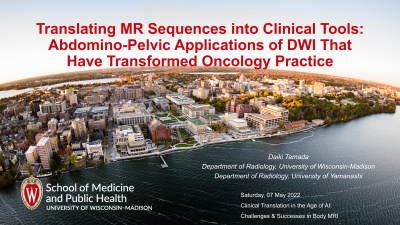Weekend Course
Clinical Translation in the Age of AI: Challenges & Successes in Body MRI
Joint Annual Meeting ISMRM-ESMRMB & ISMRT 31st Annual Meeting • 07-12 May 2022 • London, UK

| Pulmonary MRI | |||
| 08:00 | Pulmonary MRI: How to Do It
Yoshiharu Ohno
In 2020, the Fleischner Society published a new report, which provides consensus expert opinions regarding appropriate clinical indications of pulmonary MR imaging for not only oncologic but also pulmonary diseases. In this lecture, I present MR imaging for thoracic diseases regarding its technical aspects and major clinical indications in Japan 1) in terms of what is currently available, 2) promising but requiring further validation or evaluation, and 3) developments warranting research investigations in preclinical or patient studies.
|
||
| 08:25 | Pulmonary MRI: Applications in Clinical Practice Video Unavailable |
||
| Translation in Body MRI | |||
| 08:50 |  |
Translating MR Sequences into Clinical Tools: Abdomino-Pelvic Applications of DWI That Have Transformed Oncology Practice
Daiki Tamada
Diffusion-weighted imaging (DWI), which relies on microscopic motion in the cell, is an essential tool to diagnose and evaluate lesions in the body. However, many challenges remain, such as artifacts, low-SNR, long scan time, and comprehensive interpretation. Recently, artificial intelligence (AI) approaches have been proposed to address these challenges. Furthermore, recent deep learning approaches enabled innovative applications. This talk aims to review the emerging applications using AIs for body DWI.
|
|
| 09:15 | Translating MR Interventions into Clinical Workflow: MR-Guided HIFU
Holger Grull
MR-HIFU is a non-invasive method to heat tissue to ablative or hyperthermic temperatures. For therapy planning and temperature monitoring, this treatment is performed under MR guidance offering high resolution anatomical images as well as near-real time temperature mapping. Currently clinical use is restricted to CE-applications such as ablation of uterine fibroids, osteoid osteomas or desmoid tumors. In this presentation, we showcase the research and clinical translation of treatment of facet joint arthritis and pancreatic cancer from small to large animal models to clinical trials. Regulatory hurdles that need to be addressed will be discussed including the clinical trials.
|
||
| 09:40 | Break & Meet the Teachers |
||
| Translation of AI-Based MR Acquisition | |||
| 10:05 | Diagnostic Confidence in Deep Learning-Accelerated Sequences of the Body Video Unavailable |
||
| 10:30 | Machine Learning Methods for MRI Segmentation & Classification in the Abdomen
Sergios Gatidis
.
|
||
| Translation in Body MRI | |||
| 10:55 | AI Applications for Prostate Cancer: Staging, Prediction & Prognosis
Chan Kyo Kim
|
||
| Translation of AI-Based Decision Making | |||
| 11:20 | AI Applications for Rectal Cancer: Staging, Prediction & Prognosis
Iva Petkovska
|
||
The International Society for Magnetic Resonance in Medicine is accredited by the Accreditation Council for Continuing Medical Education to provide continuing medical education for physicians.